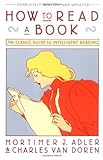And then I started to realize that I was doing it again. Doing what? Feeling like I'd "absorbed enough to pass the next test or get through the final exam" is what. I felt like I needed to step back (again), refocus, and get a little deeper.
I think the issue is that the Great Ideas are so untouched by our modern school system that they are unfamiliar as concepts. Not the ideas themselves, but the list of them. It's not like we ever had a class on them or even heard them referenced for what they were. We may have touched on summaries of different works (I remember having to memorize S.P.A. in order to get the order of Socrates, Plato, Aristotle correct. Also, we were told that Clouds was really important. Just not why.), but they were never presented as a flowing conversation through time between the great thinkers.
 So, for the past few weeks, I've been reading Dr. Adler's How to Think About the Great Ideas. This is actually a transcription of a half-hour weekly television show that aired in San Francisco in 1953 and 1954. There are 52 "chapters" that cover different ideas like education, God, truth, justice, war and peace, etc.
So, for the past few weeks, I've been reading Dr. Adler's How to Think About the Great Ideas. This is actually a transcription of a half-hour weekly television show that aired in San Francisco in 1953 and 1954. There are 52 "chapters" that cover different ideas like education, God, truth, justice, war and peace, etc.This must have been a wonderful show. I really can't think of anything airing today that approaches it. Even the "educational" shows are so packaged and complete that you aren't really able to form your own opinion; you simply assimilate the information presented and move on to the next show. Dr. Adler's show was completely different. It was a conversation, literally, between himself and Lloyd Luckman and peppered with insightful questions mailed in by viewers.
I'm seriously considering purchasing DVDs of the original series, but the complete set is a little pricey (!). While it would cost more to purchase them singly in the long run, my budget would not shriek so loudly if I spread the cost out a bit. So, I think I may start accumulating these down the road.
 Anyway, I feel like I have at least some grounding in what the Great Ideas actually are, but I thought I could still use some instruction on how to really get the most out of my reading. So, now I've moved on to another book from Dr. Adler, How to Read a Book. I must admit, I giggled a little over the title. I mean, it's almost a parody. A book on how to read a book? And in the introduction (this is a republication from the 70s, the book was first published in the 30s), Dr. Adler himself says that the initial publication was followed by an actual parody entitled How to Read Two Books. I didn't feel so bad about laughing after I read that.
Anyway, I feel like I have at least some grounding in what the Great Ideas actually are, but I thought I could still use some instruction on how to really get the most out of my reading. So, now I've moved on to another book from Dr. Adler, How to Read a Book. I must admit, I giggled a little over the title. I mean, it's almost a parody. A book on how to read a book? And in the introduction (this is a republication from the 70s, the book was first published in the 30s), Dr. Adler himself says that the initial publication was followed by an actual parody entitled How to Read Two Books. I didn't feel so bad about laughing after I read that.The point of this book is to teach you how to read a book based on its level, to be an active and questioning reader, and to fully absorb the message the author is attempting to convey. Dr. Adler says the sign of active reading is marking your books up, underlining, writing notes in the margins, circling phrases... all things I'd rather not do to my pretty set of Great Books. Thankfully, you can pretty much get all of the Great Books on Kindle for free or close to it. And while I love my Kindle, the tiny little keyboard isn't conducive to extensive note-taking, so I'll take advantage of the free Kindle for PC app Amazon provides and use my laptop to do some fully active reading once the kids are all asleep.
I am beginning to understand why the Great Conversation reading list is supposed to take a full ten years to complete.

No comments:
Post a Comment